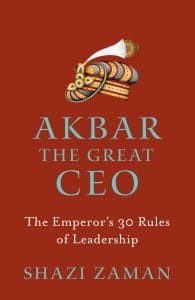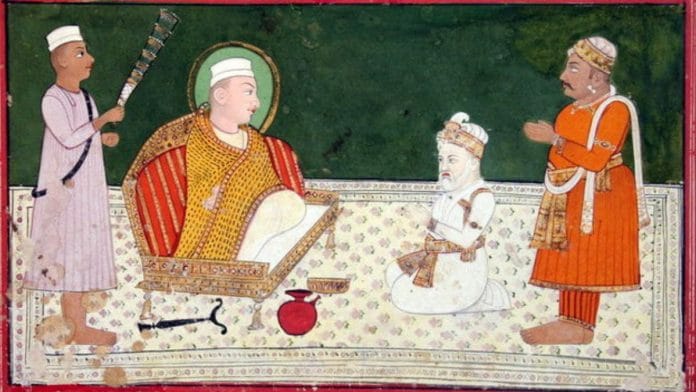The Mughal Emperor could be called a networked individual. In fact, networking was one of his prime responsibilities. It was his way of building trust and relationships for the running of an enterprise as difficult as an empire. And this networking started early—much before he became king.
Mughal princes had mansabs and administrative responsibilities and establishments of their own. In the course of their princely career they gathered experience and built networks which were important to create a base of power. All the resources and experience they gathered and relationships they built was of course useful in the discharge of their administrative responsibilities but came in especially handy at a time when daggers were finally drawn for the battle of succession.
In the case of Akbar, two of his three sons—Murad and Daniyal—did not live to fight that battle but they were definitely given responsibilities to prove themselves. Murad had held the position of Subadar of Malwa, Gujarat and the Deccan. Daniyal had been the Subadar of Allahabad and the Deccan. The surviving son—who was also the eldest—Salim (later Jahangir), was the Subadar of Allahabad. He built an effective base and network and started adopting independent airs years before the throne became empty.
For Akbar and his sons, matrimonial relationships were an important part of networking. When, early in his reign, Akbar married the daughter of Raja Bharmal who was the Rajput ruler of Amber—and this was the first in a series of marriages with Rajput royalty—he was laying the foundation of a long partnership. Raja Bharmal, his son Raja Bhagwant Das and grandson Raja Man Singh became pillars of the empire and discharged important administrative and military responsibilities. Raja Man Singh, the nephew of Akbar’s wife, was so dear to the Emperor that he was affectionately called farzand—son.
Also read: Rajputs were unsuccessful statesmen because revenge is their moral obligation
When Akbar was on his deathbed, a succession dispute arose between his son Prince Salim and his grandson Prince Khusrau—both men of connections. Salim’s mother was the daughter of Raja Bharmal, the Rajput ruler of Amber. Salim himself was married to the daughter of Raja Bhagwant Das, who was the son of Raja Bharmal. Prince Khusrau was born of this marriage.
In addition, Salim was married to the daughter of Mota Raja Udai Singh of Jodhpur (Khurram—the future Shahjahan—was born of this wedlock). Khusrau being related to the Amber royalty on his mother’s side—the Amber princess married to his father Prince Salim—could count upon the support of his maternal uncle Raja Man Singh. In addition, Khusrau was married to the daughter of Mirza Aziz Koka, a high ranking noble and Emperor Akbar’s foster brother, whose other daughter was married to Prince Salim’s younger brother, Prince Murad.
And this brings us to another crucial network that bound the Emperor to his foster family. Akbar used to say about Mirza Aziz Koka, “I am bound to him by a stream of milk.” Ladies who had breast-fed the infant Akbar were called Anga and were highly respected by the Emperor. Their husbands, called Atka, and their sons, called Koka, enjoyed a high station and had a good chance of rising high in the imperial hierarchy.
It is worthwhile to recall that outside of the royal family only two people enjoyed a mansab—rank—higher than all other nobles. These were Raja Man Singh, who was Akbar’s nephew by marriage, and Mirza Aziz Koka whose mother had breast-fed Akbar.
There were numerous other ways the Emperor would make or reinforce bonds. When the Emperor bestowed a highly valued honour like the khilat—robe—or a title, he was creating a personal bond with that person. The protocol associated with the Emperor created and reinforced his linkages with people. By appearing on the jharokha—balcony—every morning of his reign, he created a personal bond with his subjects.
The daily darbar created a bond with the nobles, the favoured amongst them getting a place to the right of the Emperor. While the princes got to stand nearer, the highest nobles stood at a distance of three to fifteen yards, the next highest from three and a half yards and then the rest of the nobles from ten or twelve and a half yards from the throne. Notably, there was a clear hierarchy in the darbar, measured in terms of distance from the place where His Majesty was seated.
Those appearing before the king were expected to offer taslim or kornish. Abul Fazl wrote: “Superficial observers, correctly enough, look upon a king as the origin of the peace and comforts of the subjects. But men of deeper insight are of opinion that even spiritual progress among a people would be impossible unless emanating from the king, in whom the light of God dwells; for near the throne, men wipe off the stain of conceit and build up the arch of true humility… His Majesty has commanded the palm of the right hand to be placed upon the forehead and the head to be bent downwards. This mode of salutation, in the language of the present age, is called kornish and signifies that the saluter has placed his head (which is the seat of the senses and the mind) into the hand of humility, giving it to the royal assembly as a present, and has made himself in obedience ready for any service that may be required of him. The salutation, called taslim, consists in placing the back of the right hand on the ground, and then raising it gently till the person stands erect, when he puts the palm of his hand upon the crown of his head, which pleasing manner of saluting signifies that he is ready to give himself as offering.”
 This excerpt from ‘Akbar the Great CEO: The Emperor’s 30 Rules of Leadership’ by Shazi Zaman has been published with permission from Speaking Tiger Books.
This excerpt from ‘Akbar the Great CEO: The Emperor’s 30 Rules of Leadership’ by Shazi Zaman has been published with permission from Speaking Tiger Books.






